A Satellite-Based High-Resolution (1-km) Ambient PM2.5 Database for India over Two Decades (2000–2019): Applications for Air Quality Management
Abstract
1. Introduction
2. Materials and Methods
2.1. Details of the Algorithm to Estimate PM2.5 from Satellite AOD
2.2. Comparison of Satellite-Derived and Ground-Based Daily and Annual PM2.5
2.3. Analysis of PM2.5 Trends and Meteorological Parameters
2.4. Exposure Attribution
3. Results
3.1. Spatial Pattern in PM2.5 Concentration over India
3.2. Seasonal Anomaly in PM2.5 Concentration
3.3. Trends in PM2.5 Concentration
3.4. Urban vs. Rural PM2.5
4. Discussion
5. Conclusions
Author Contributions
Funding
Acknowledgments
Conflicts of Interest
Appendix A
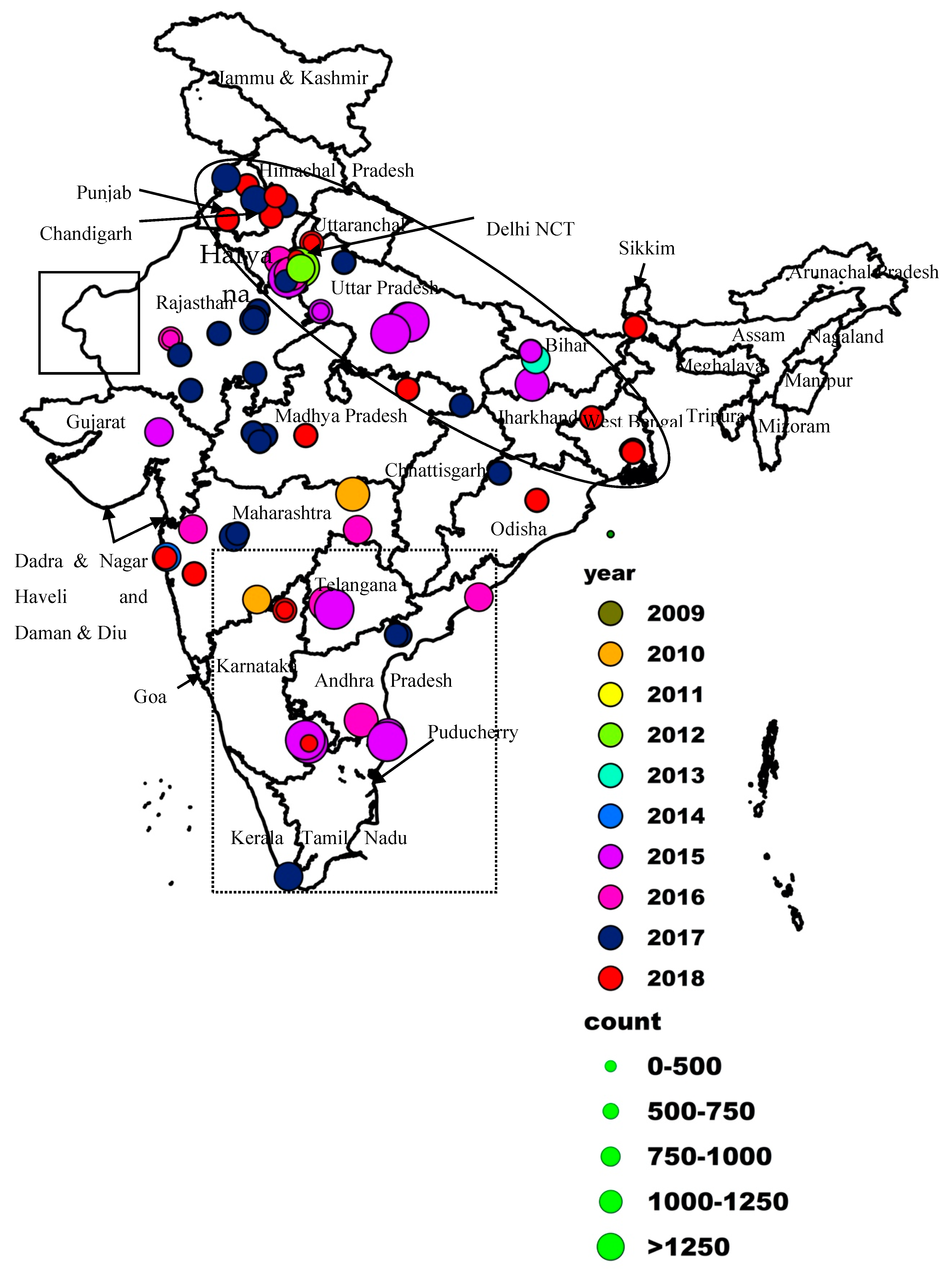
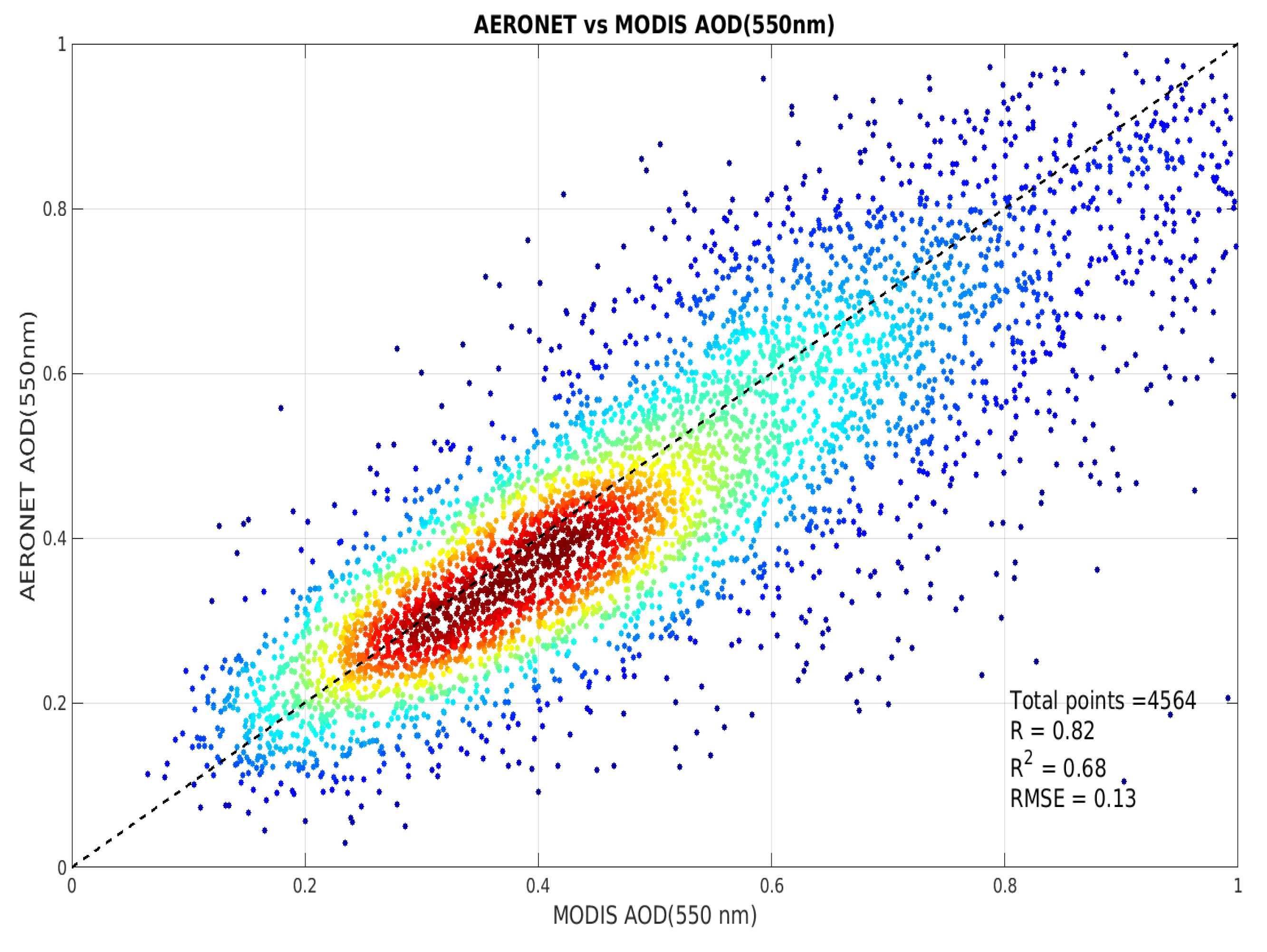
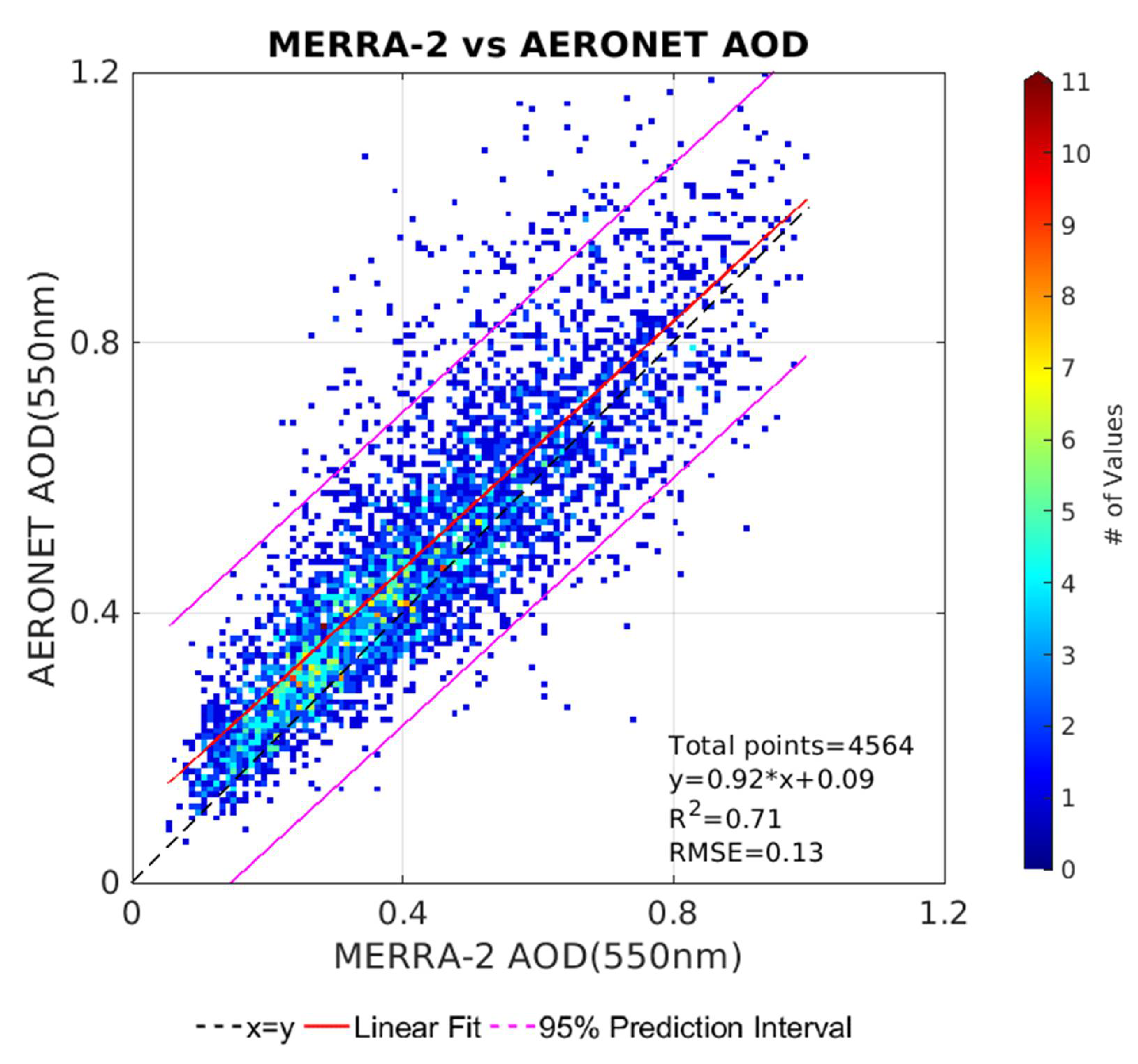
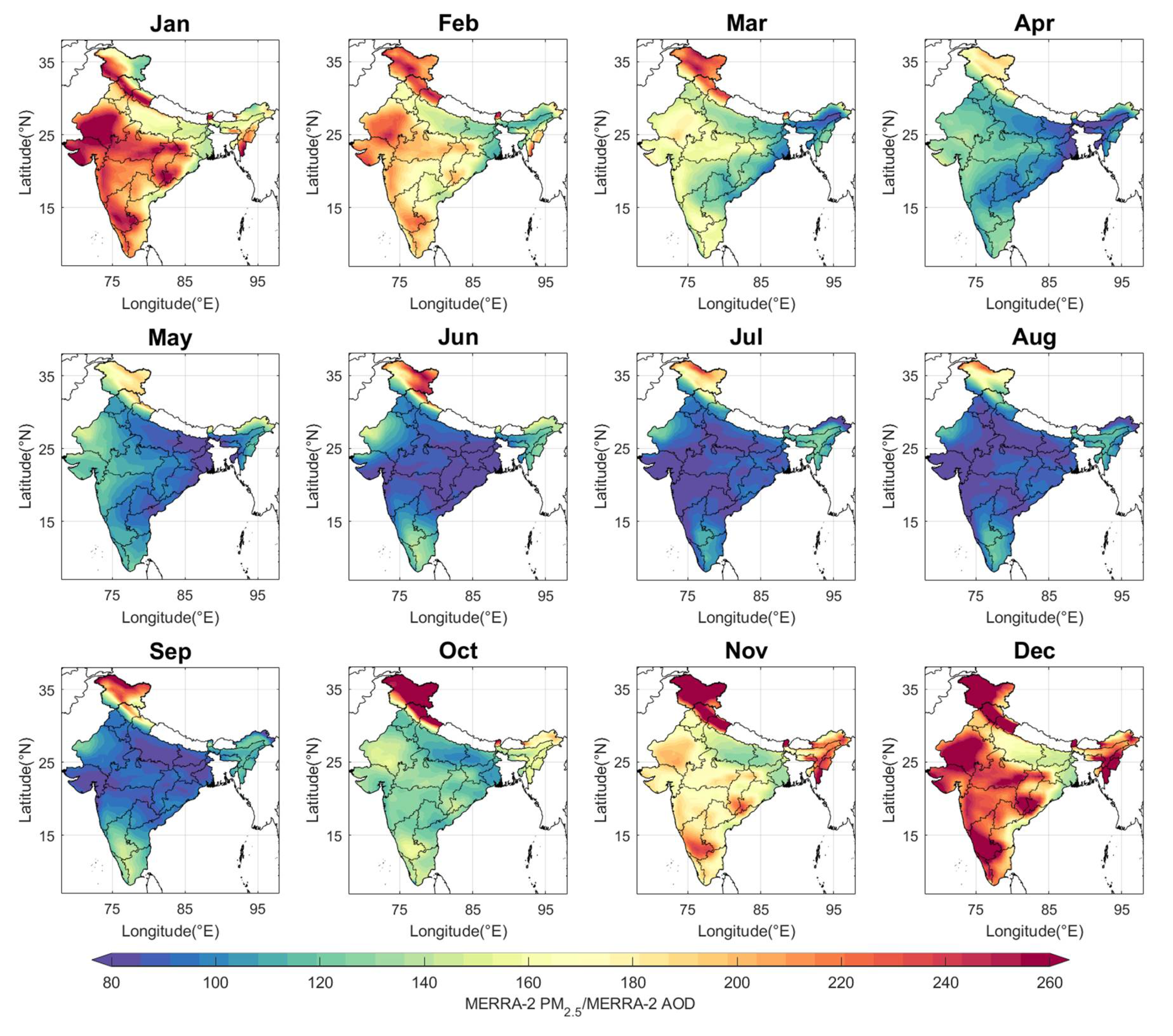
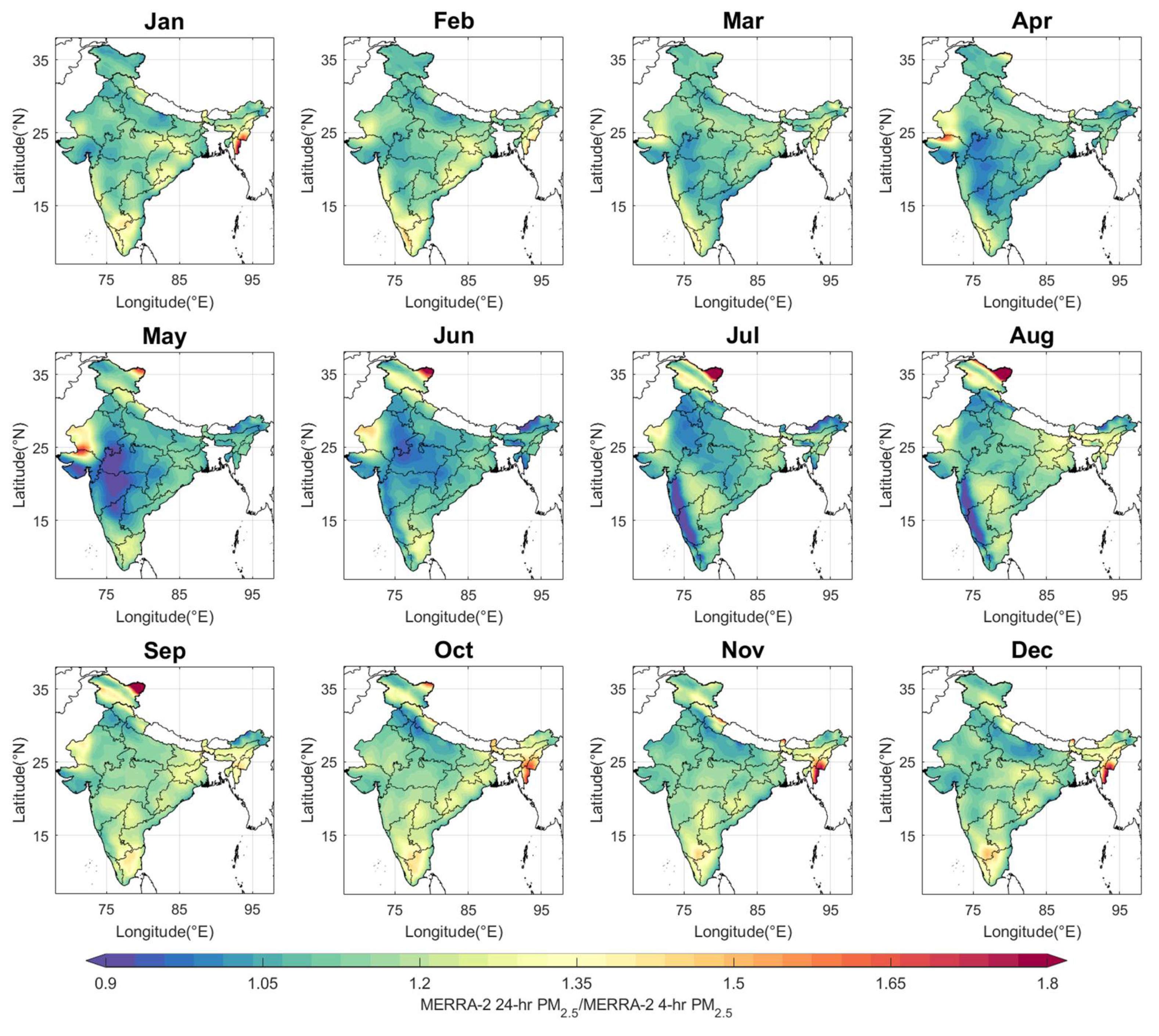
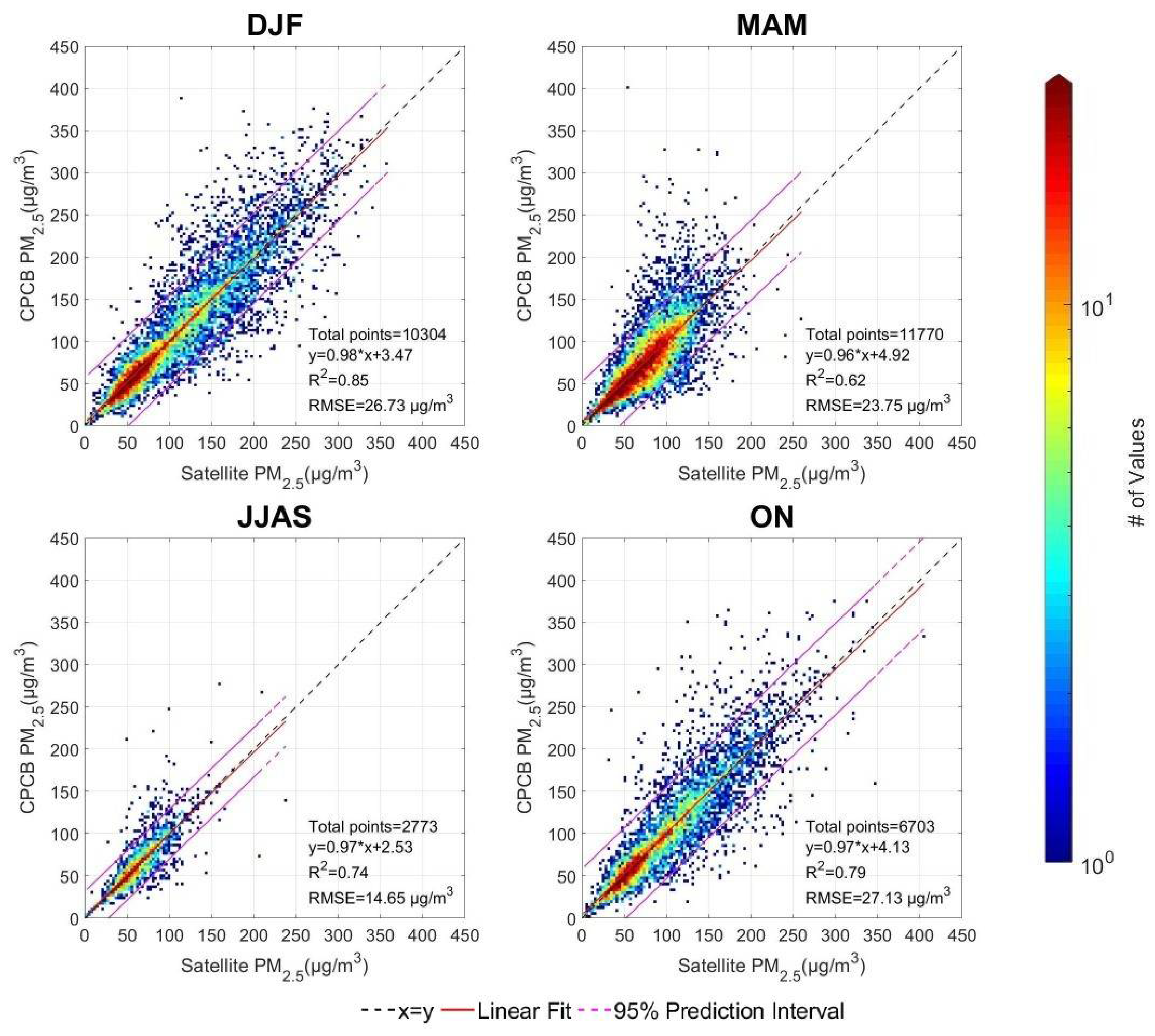

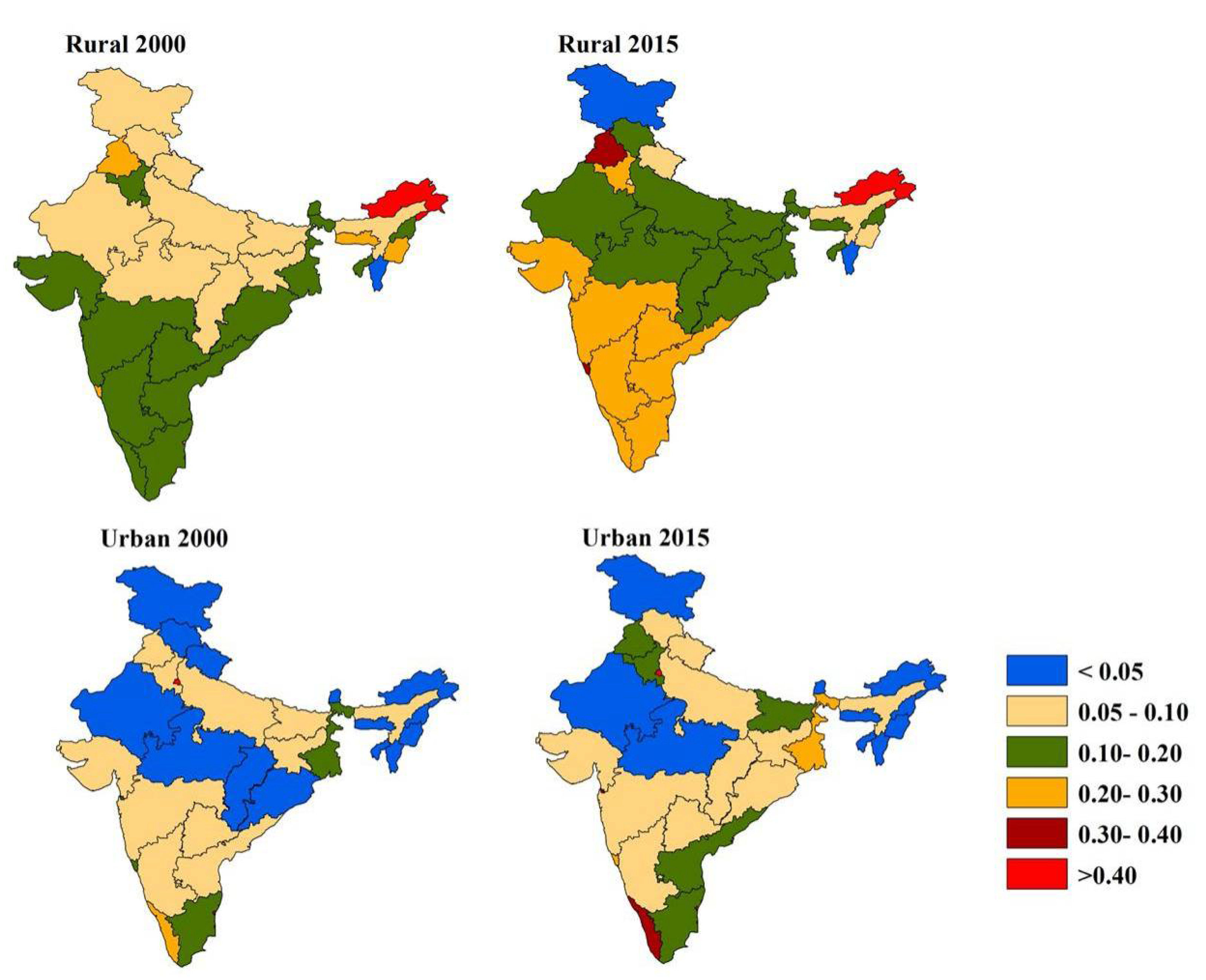
| State/UT | PM2.5 in 2001 (μg/m3) | PM2.5 in 2019 (μg/m3) | Change in Urban Exposure from 2001–2015 (%) | Change in Rural Exposure from 2001–2015 (%) |
|---|---|---|---|---|
| Chandigarh | 62.0 (23.9–127.2) | 61.9 (24.5–141.5) | 18.7 | 13.4 |
| Delhi national capital territory | 82.3 (27.9–169.8) | 86.7 (34.2–185.3) | 10.9 | 11.9 |
| Puducherry | 34.6 (22.4–56.7) | 44.9 (21.1–80.5) | 19.7 | 9.5 |
| Dadra and Nagar Haveli | 53.3 (24.2–99.9) | 62.9 (24.6–121.9) | 19.0 | 20.3 |
| Kerala | 40.5 (19.6–75.4) | 51.1 (20.4–105.1) | 24.2 | 21.9 |
| West Bengal | 66.6 (27.3–156.8) | 78.2 (29.4–166.4) | 19.3 | 17.2 |
| Goa | 44.1 (18.5–86.4) | 60.4 (19.7–120.3) | 36.4 | 37.3 |
| Daman and Diu | 54.6 (25.9–95.8) | 61.2 (26.2–114.7) | 25.7 | 17.3 |
| Bihar | 76.2 (27.6–175.9) | 80.2 (29.7–176.2) | 7.6 | 7.8 |
| Punjab | 70.3 (31.4–140) | 73.4 (31.7–140.8) | 13.6 | 14.9 |
| Tamil Nadu | 38.5 (20.5–69.8) | 47.2 (21.9–91.6) | 10.1 | 11.1 |
| Haryana | 75.9 (29.9–155.1) | 81.5 (33.5–162.4) | 13.6 | 13.2 |
| Andhra Pradesh | 42.3 (21.1–77.8) | 54.6 (21.9–121.2) | 20.1 | 18.9 |
| Uttar Pradesh | 71.8 (26.3–163.8) | 79.3 (31–164.7) | 13.2 | 13.7 |
| Telangana | 47.5 (23.6–89.1) | 58.4 (24.1–113.7) | 14.6 | 16.5 |
| Jharkhand | 68.4 (27.4–144.9) | 79.1 (28.1–164.5) | 15.1 | 16.2 |
| Karnataka | 42.4 (16.9–84.3) | 51.3 (16.8–104.5) | 16.6 | 17.1 |
| Gujarat | 54.7 (31.2–92.9) | 63.4 (28–108.3) | 16.5 | 16.7 |
| Maharashtra | 48.3 (21.7–83) | 58.1 (22.4–107) | 24.0 | 21.0 |
| Assam | 45.7 (16.4–111.5) | 48.4 (17.3–97.9) | 11.0 | 12.7 |
| Odisha | 55.7 (26.1–109.2) | 72.7 (25.6–153.1) | 28.2 | 28.3 |
| Tripura | 50.1 (17–149.7) | 48.6 (16.8–102.1) | 4.9 | 23.8 |
| Uttarakhand | 42.5 (12.4–68.3) | 41.4 (15.4–73.8) | 16 | 13.7 |
| Madhya Pradesh | 53.8 (24.6–106.2) | 60.3 (26.4–117) | 11.2 | 12.8 |
| Chhattisgarh | 51.8 (23.7–96.3) | 60.2 (23.2–121.5) | 17.3 | 17.6 |
| Himachal Pradesh | 27.0 (13.3–52.8) | 23.9 (12.1–50.2) | 8.0 | 8.5 |
| Rajasthan | 74.8 (35.4–139.4) | 74.7 (35.8–133) | 7.5 | 7.9 |
| Manipur | 35.6 (5.6–94.9) | 36.1 (6.5–90.2) | 13.4 | 16.2 |
| Jammu and Kashmir | 17.1 (9.8–38.7) | 13.1 (6.5–33.5) | 2.1 | 7.3 |
| Nagaland | 36.2 (7.2–95.2) | 37.9 (7.7–96.6) | 17.5 | 17.1 |
| Meghalaya | 49.6 (16.5–139.7) | 49.9 (17.4–107.4) | 5.4 | 6.4 |
| Mizoram | 41.0 (7.5–115.3) | 42.3 (8.3–97.7) | 18.2 | 24.1 |
| Arunachal Pradesh | 23.3 (4.1–63) | 25.9 (4.9–77.9) | 13.4 | 18.9 |
| Sikkim | 27.9 (5.1–59.2) | 29.4 (6.1–55) | 0.2 | −4.3 |
References
- Dandona, L.; Dandona, R.; Kumar, G.A.; Shukla, D.K.; Paul, V.K.; Balakrishnan, K.; Prabhakaran, D.; Tandon, N.; Salvi, S.; Dash, A.P.; et al. Nations within a nation: Variations in epidemiological transition across the states of India, 1990–2016 in the Global Burden of Disease Study. Lancet 2017, 390, 2437–2460. [Google Scholar] [CrossRef]
- Cohen, A.J.; Brauer, M.; Burnett, R.; Anderson, H.R.; Frostad, J.; Estep, K.; Balakrishnan, K.; Brunekreef, B.; Dandona, L.; Dandona, R.; et al. Estimates and 25-year trends of the global burden of disease attributable to ambient air pollution: An analysis of data from the Global Burden of Disease Study 2015. Lancet 2017, 389, 1907–1918. [Google Scholar] [CrossRef]
- Dey, S.; Di Girolamo, L.; van Donkelaar, A.; Tripathi, S.N.; Gupta, T.; Mohan, M. Decadal exposure to fine particulate matter (PM2.5) in the Indian Subcontinent using remote sensing data. Remote Sens. Environ. 2012, 127, 153–161. [Google Scholar] [CrossRef]
- Balakrishnan, K.; Dey, S.; Gupta, T.; Dhaliwal, R.S.; Brauer, M.; Cohen, A.J.; Stanaway, J.D.; Beig, G.; Joshi, T.K.; Aggarwal, A.N.; et al. The impact of air pollution on deaths, disease burden, and life expectancy across the states of India: The Global Burden of Disease Study 2017. Lancet Planet. Health 2019, 3, 26–39. [Google Scholar] [CrossRef]
- Chowdhury, S.; Dey, S. Cause-specific premature death from ambient PM2.5 exposure in India: Estimate adjusted for baseline mortality. Environ. Int. 2016, 91, 283–290. [Google Scholar] [CrossRef] [PubMed]
- Apte, J.; Brauer, M.; Cohen, A.J.; Ezzati, M.; Pope, C.A. Ambient PM2.5 reduces global and regional life expectancy. Environ. Sci. Technol. Lett. 2018, 5, 546–551. [Google Scholar] [CrossRef]
- Martin, R.V.; Brauer, M.; van Donkelaar, A.; Shaddick, G.; Narain, U.; Dey, S. no one knows which city has the highest concentration fine particulate matter. Atmos. Environ. 2019, 3, 100040. [Google Scholar] [CrossRef]
- Pant, P.; Lal, R.M.; Guttikunda, S.K.; Russell, A.G.; Nagpure, A.S.; Ramaswami, A.; Peltier, R.E. Monitoring particulate matter in India: Recent trends and future outlook. Air Qual. Atmos. Health 2019, 12, 45–58. [Google Scholar] [CrossRef]
- Brauer, M.; Guttikunda, S.K.; Nishad, K.A.; Dey, S.; Tripathi, S.N.; Weagle, C.; Martin, R.V. Examination of monitoring approaches for ambient air pollution: A case study for India. Atmos. Environ. 2019, 216, 116940. [Google Scholar] [CrossRef]
- Gordon, T.; Balakrishnan, K.; Dey, S.; Rajagopalan, S.; Thornburg, J.; Thurston, G.; Agrawal, A.; Collman, G.; Guleria, R.; Limaye, S.; et al. Air pollution health research priorities for India: Perspectives of the Indo-U.S. communities of researchers. Environ. Int. 2018, 119, 100–108. [Google Scholar] [CrossRef]
- Pal, R.; Chowdhury, S.; Dey, S.; Sharma, A.R. 18-year ambient PM2.5 exposure and nightlight rends in Indian cities: Vulnerability assessment. Aerosol Air Qual. Res. 2018, 18, 2332–2342. [Google Scholar] [CrossRef]
- Pande, P.; Dey, S.; Chowdhury, S.; Choudhary, P.; Ghosh, S.; Srivastava, P.; Sengupta, B. Seasonal transition in PM10 exposure and associated all-cause mortality risks in India. Environ. Sci. Technol. 2018, 52, 8756–8763. [Google Scholar] [CrossRef] [PubMed]
- Chowdhury, S.; Dey, S.; Di Girolamo, L.; Smith, K.R.; Pillarisetti, A.; Lyapustin, A. Tracking ambient PM2.5 buildup in Delhi national capital region during the dry season over 15 years using a high-resolution (1-km) satellite aerosol dataset. Atmos. Environ. 2019, 204, 142–150. [Google Scholar] [CrossRef]
- Mhawish, A.; Banerjee, T.; Sorek-Hamer, M.; Bilal, M.; Lyapustin, A.; Chatfield, R.; Broday, D.M. Estimation of high-resolution PM2.5 over the Indo-Gangetic Plain by fusion of satellite data, meteorology, and land use variables. Environ. Sci. Technol. 2020, 54, 7891–7900. [Google Scholar] [CrossRef]
- Yazdi, M.D.; Kuang, Z.; Dimakopouou, K.; Baratt, B.; Suel, E.; Amini, H.; Lyapustin, A.; Katsouyanni, K.; Schwartz, J. Predicting fine particulate matter (PM2.5) in the Greater London area: An ensemble approach using machine learning methods. Remote Sens. 2020, 12, 914. [Google Scholar] [CrossRef]
- van Donkelaar, A.; Martin, R.V.; Brauer, M.; Kahn, R.A.; Levy, R.C.; Verduzco, C.; Villeneuve, P.J. Global estimates of ambient particulate matter concentrations from satellite-based aerosol optical depth: Development and application. Environ. Health Perspect. 2010, 118, 847–855. [Google Scholar] [CrossRef] [PubMed]
- van Donkelaar, A.; Martin, R.V.; Brauer, M.; Hsu, N.C.; Kahn, R.A.; Levy, R.C.; Lyapustin, A.; Sayer, A.M.; Winker, D.M. Global estimates of fine particulate matter using a combined geophysical-statistical method with information from satellites, models, and monitors. Environ. Sci. Technol. 2016, 50, 3762–3772. [Google Scholar] [CrossRef]
- van Donkelaar, A.; Martin, R.V.; Brauer, M.; Boys, B.L. Use of satellite observations for long-term exposure assessment of global concentrations of fine particulate matter. Environ. Health Perspect. 2015, 123, 135–143. [Google Scholar] [CrossRef]
- Hammar, M.S.; van Donkelaar, A.; Li, C.; Lyapustin, A.; Sayer, A.M.; Hsu, N.C.; Levy, R.C.; Garay, M.J.; Kalashnikova, O.V.; Kahn, R.A.; et al. Global estimates and long-term trends of fine particulate matter concentrations (1998–2018). Environ. Sci. Technol. 2020, 54, 7879–7890. [Google Scholar] [CrossRef]
- Shaddick, G.; Thomas, M.L.; Amini, H.; Broday, D.; Cohen, A.; Frostad, J.; Green, A.; Gumy, S.; Liu, Y.; Martin, R.V.; et al. Data integration for the assessment of population exposure to ambient air pollution for global burden of disease assessment. Environ. Sci. Technol. 2018, 52, 9069–9078. [Google Scholar] [CrossRef]
- Lyapustin, A.; Wang, Y.; Korkin, S.; Huang, D. MODIS collection 6 MAIAC algorithm. Atmos. Meas. Tech. 2018, 11, 5741–5765. [Google Scholar] [CrossRef]
- Mhawish, A.; Banerjee, T.; Sorek-Hamer, M.; Lyapustin, A.; Broday, D.M.; Chatfield, R. Comparison and evaluation of MODIS Multi-angle Implementation of Atmospheric Correction (MAIAC) aerosol product over South Asia. Remote Sens. Environ. 2019, 224, 12–28. [Google Scholar] [CrossRef]
- Holben, B.; Eck, T.; Slutsker, I.; Tanré, D.; Buis, J.; Setzer, A.; Vermote, E.; Reagan, J.; Kaufman, Y.; Nakajima, T.; et al. AERONET—A federated instrument network and data archive for aerosol characterization. Remote Sens. Environ. 1998, 66, 1–16. [Google Scholar] [CrossRef]
- Kloog, I.; Chudnovsky, A.A.; Just, A.C.; Nordio, F.; Koutrakis, P.; Coull, B.A.; Lyapustin, A.; Wang, Y.; Schwartz, J. A new hybrid spatio-temporal model for estimating daily multi-year PM2.5 concentrations across northeastern USA using high resolution aerosol optical depth data. Atmos. Environ. 2014, 95, 581–590. [Google Scholar] [CrossRef]
- Buchard, V.; Randles, C.A.; Da Silva, A.M.; Darmenov, A.; Colarco, P.R.; Govindaraju, R.; Ferrare, R.; Hair, J.; Beyersdorf, A.J.; Ziemba, L.D.; et al. The MERRA-2 aerosol reanalysis, 1980-onward, Part II: Evaluation and case studies. J. Clim. 2017, 30, 6851–6872. [Google Scholar] [CrossRef]
- Ram, K.; Sarin, M.M.; Tripathi, S.N. Temporal trends in atmospheric PM2.5, PM10, elemental carbon, organic carbon, water-soluble organic carbon, and optical properties: Impact of biomass burning emissions in the Indo-Gangetic Plain. Environ. Sci. Technol. 2010, 46, 686–695. [Google Scholar] [CrossRef]
- Navinya, C.D.; Vinoj, V.; Pandey, S.K. Evaluation of PM2.5 surface concentrations simulated by NASA’s MERRA Version 2 aerosol reanalysis over India and its relation to air quality index. Aerosol Air Qual. Res. 2020, 20, 1329–1339. [Google Scholar] [CrossRef]
- Central Pollution Control Board, Government of India Website. Available online: www.cpcb.nic.in (accessed on 1 May 2020).
- Gani, S.; Bhandari, S.; Seraj, S.; Wang, D.S.; Patel, K.; Soni, P.; Arub, Z.; Habib, G.; Ruiz, L.H.; Apte, J.S. Submicron aerosol composition in the world’ most polluted megacity: The Delhi aerosol supersite study. Atmos. Chem. Phys. 2019, 19, 6843–6859. [Google Scholar] [CrossRef]
- Dijkstra, L.; Poelmann, H. A harmonized definition of cities and rural areas: The new degree of urbanization. Eur. Comm. Urban Reg. Pol. 2014. Available online: https://ec.europa.eu/regional_policy/sources/docgener/work/2014_01_new_urban.pdf (accessed on 1 May 2020).
- Dey, S.; Di Girolamo, L. A climatology of aerosol optical and microphysical properties over the Indian Subcontinent from 9 years (2000–2008) of Multiangle Imaging SpectroRadiometer (MISR) data. J. Geophys. Res. 2010, 115, D15204. [Google Scholar] [CrossRef]
- Chowdhury, S.; Dey, S.; Ghosh, S.; Saud, T. Satellite-based estimates of aerosol washout and recovery over India during monsoon. Aerosol Air Qual. Res. 2016, 16, 629–639. [Google Scholar] [CrossRef]
- Stohl, A.; Aamaas, B.; Amann, M.; Baker, L.H.; Bellouin, N.; Berntsen, T.K.; Boucher, O.; Cherian, R.; Collins, W.; Daskalakis, N.; et al. Evaluating the climate and air quality impacts of short-lived pollutants. Atmos. Chem. Phys. 2015, 15, 10529–10566. [Google Scholar] [CrossRef]
- Upadhyay, A.; Dey, S.; Goyal, P.; Dash, S.K. Projection of near-future anthropogenic PM2.5 over India using statistical approach. Atmos. Environ. 2018, 186, 178–188. [Google Scholar] [CrossRef]
- Bikkina, S.; Andersson, A.; Kirillova, E.N.; Holmstrand, H.; Tiwari, S.; Srivastava, A.K.; Bisht, D.S.; Gustafsson, O. Air quality in megacity Delhi affected by countryside biomass burning. Nat. Sustain. 2019, 2, 200–205. [Google Scholar] [CrossRef]
- Pandey, S.K.; Vinoj, V.; Landu, K.; Babu, S.S. Declining pre-monsoon dust loading over South Asia: Signature of a changing regional climate. Sci. Rep. 2017, 7, 16062. [Google Scholar] [CrossRef] [PubMed]
- Sahu, L.K.; Sheel, V.; Pandey, K.; Yadav, R.; Saxena, P.; Gunthe, S. Regional biomass burning trends in India: Analysis of satellite fire data. J. Earth Sys. Sci. 2015, 124, 1377–1387. [Google Scholar] [CrossRef]
- Thomas, A.; Sarangi, C.; Kanawade, V.P. Recent increase in winter hazy days over Central India and the Arabian Sea. Sci. Rep. 2019, 9, 17409. [Google Scholar] [CrossRef]
- Chafe, Z.; Brauer, M.; Klimont, Z.; van Dingenen, R.; Mehta, S.; Rao, S.; Riahl, K.; Dentener, F.; Smith, K.R. Household cooking with solid fuels contributes to ambient PM2.5 air pollution and the burden of disease. Environ. Health Perspect. 2014, 122, 1314–1320. [Google Scholar] [CrossRef]
- Lelieveld, J.; Evans, J.S.; Fnais, M.; Giannadaki, D.; Pozzer, A. The contribution of outdoor air pollution sources to premature mortality on a global scale. Nature 2015, 525, 367–371. [Google Scholar] [CrossRef]
- Conibear, L.; Butt, E.W.; Knote, C.; Arnold, S.R.; Spracklen, D.V. residential energy use emissions dominate health impacts from exposure to ambient particulate matter in India. Nat. Commun. 2018, 9, 1–9. [Google Scholar] [CrossRef]
- GBD MAPS Working Group 2018. Burden of disease attributable to major air pollution sources in India. Health Effects Institute, Boston, MA, USA. Spec. Rep. 2018, 21. Available online: https://www.healtheffects.org/publication/gbd-air-pollution-india (accessed on 1 May 2020).
- Chowdhury, S.; Dey, S.; Guttikunda, S.; Pillarisetti, A.; Smith, K.R.; Di Girolamo, L. Indian ambient air quality standard is achievable by completely mitigating emissions from household sources. Proc. Natl. Acad. Sci. USA 2019, 116, 10711–10716. [Google Scholar] [CrossRef] [PubMed]
- Upadhyay, U.; Dey, S.; Chowdhury, S.; Goyal, P. Expected health benefits from mitigation of emissions from major anthropogenic PM2.5 sources in India: Statistics at state level. Environ. Pollut. 2018, 242, 1817–1826. [Google Scholar] [CrossRef] [PubMed]
- Spears, D.; Dey, S.; Chowdhury, S.; Scovronick, N.; Vyas, S.; Apte, J. The association of early-life exposure to ambient PM2.5 and later-childhood age-for-height in India: An observational study. Environ. Health 2019, 18, 62. [Google Scholar] [CrossRef] [PubMed]
- Balakrishnan, K.; Ghosh, S.; Thangavel, G.; Sambandam, S.; Mukhopadhyay, K.; Puttaswamy, N.; Sadasivam, A.; Ramaswamy, P.; Johnson, P.; Kuppuswamy, R.; et al. Exposure to fine particulate matter (PM2.5) and birthweight in a rural-urban, mother-child cohort in Tamil Nadu, India. Environ. Res. 2018, 161, 524–531. [Google Scholar] [CrossRef]
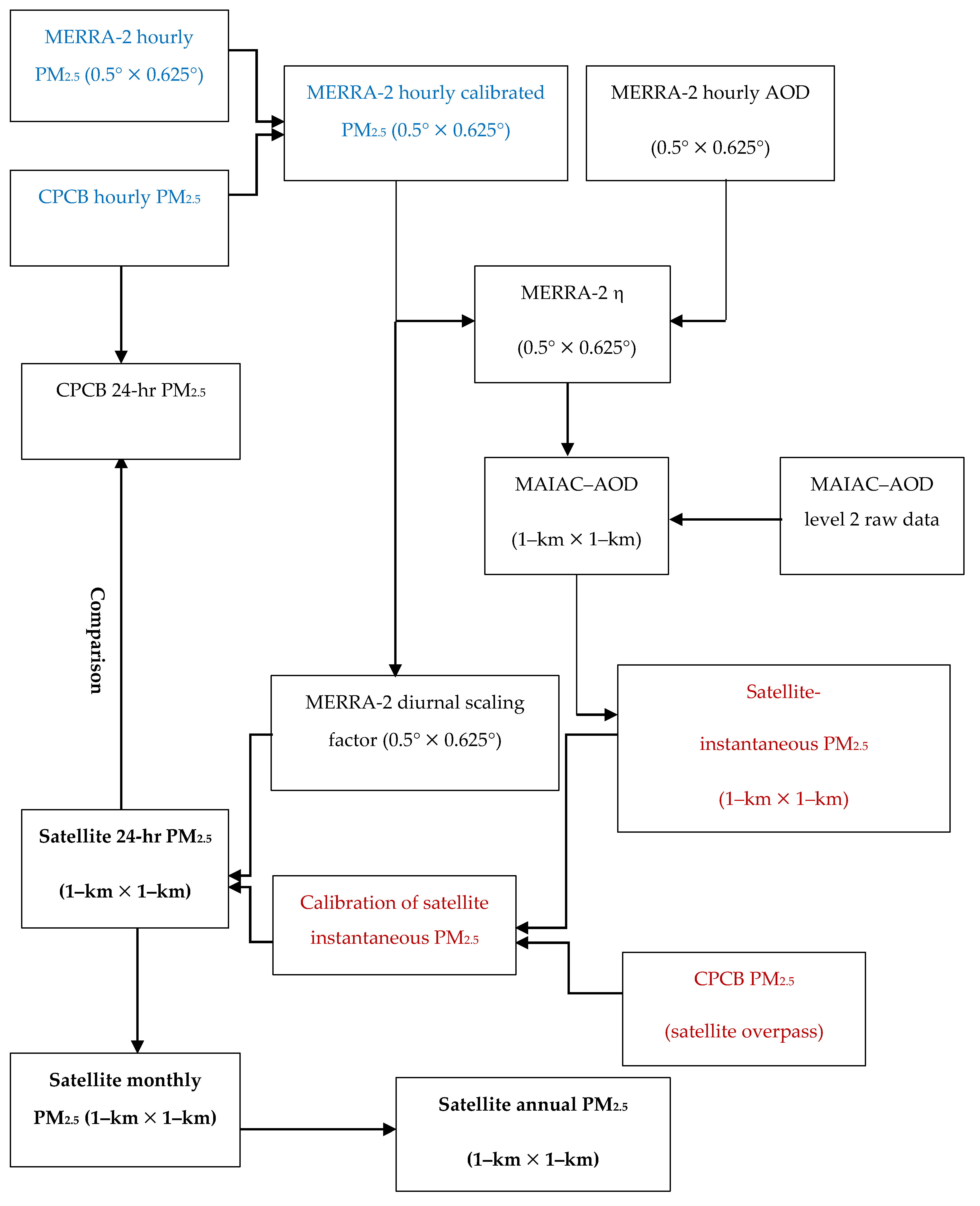
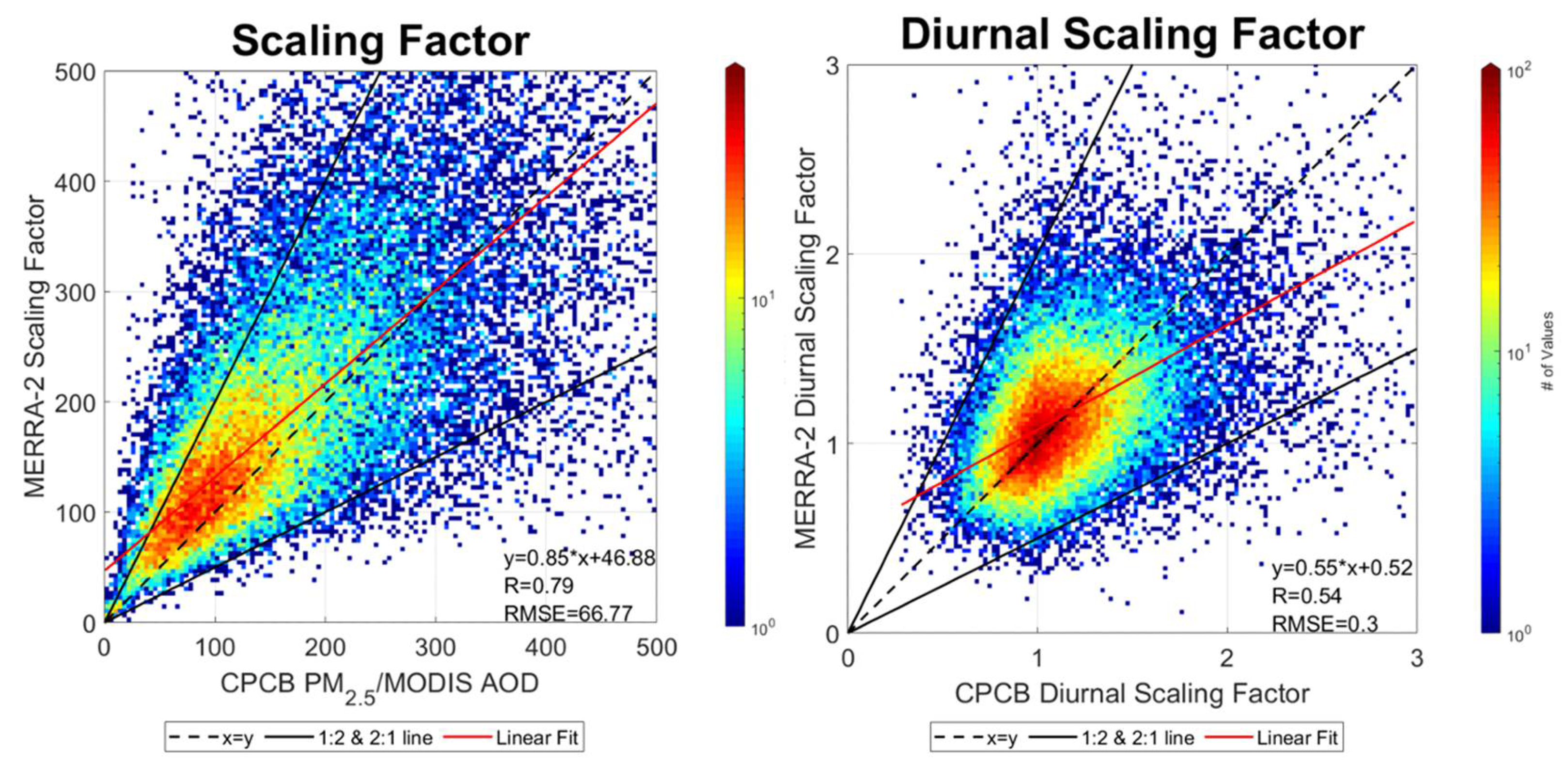

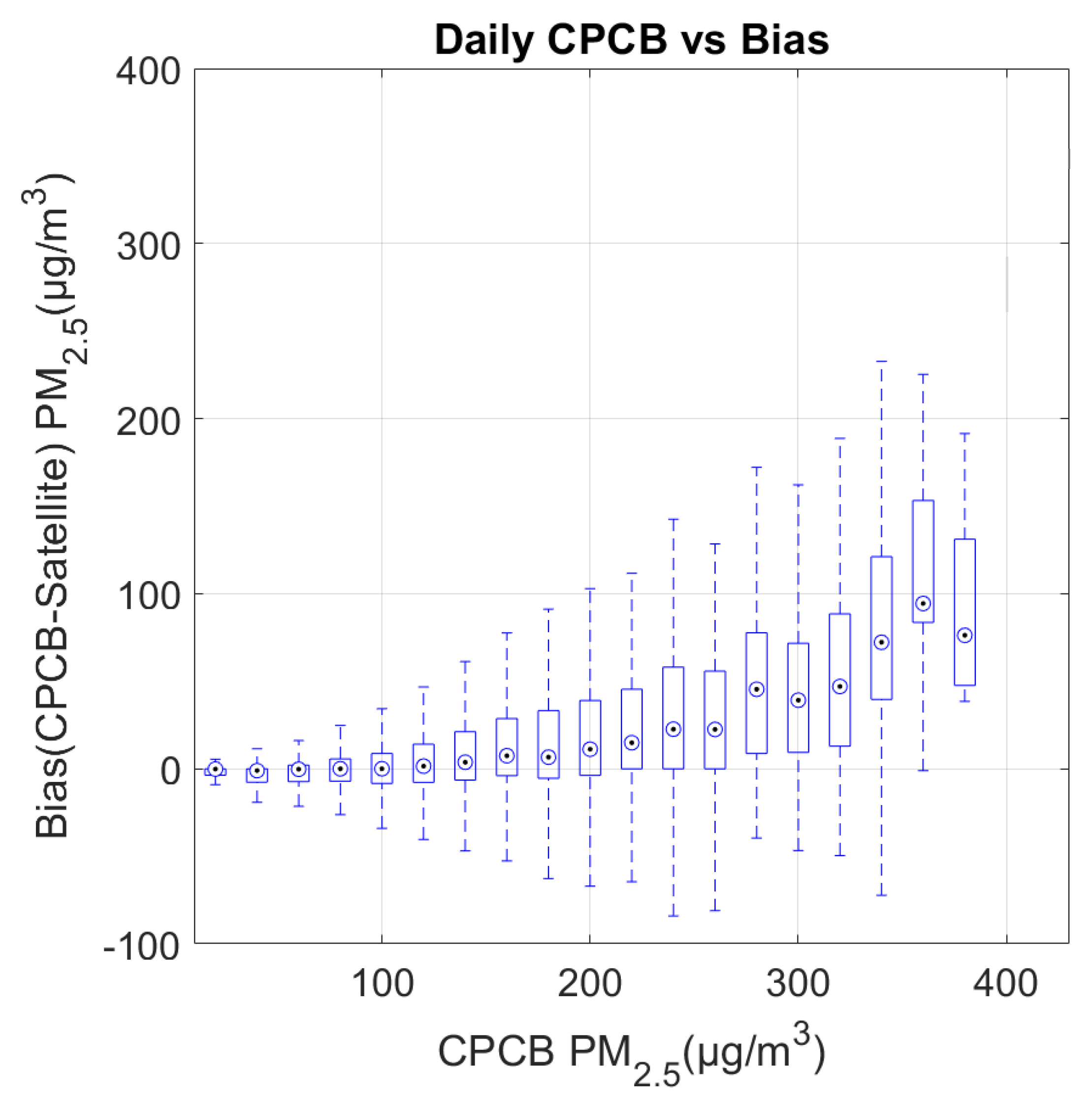
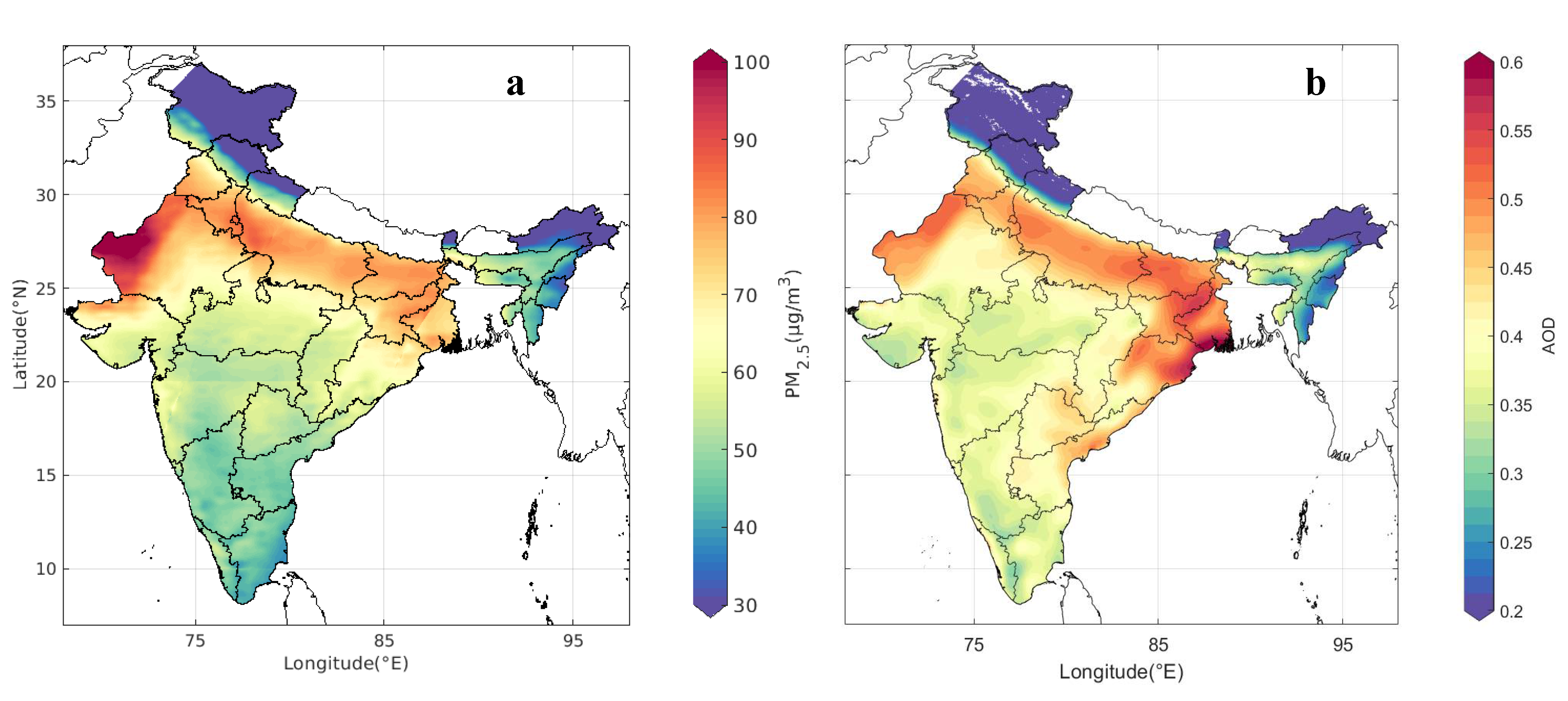
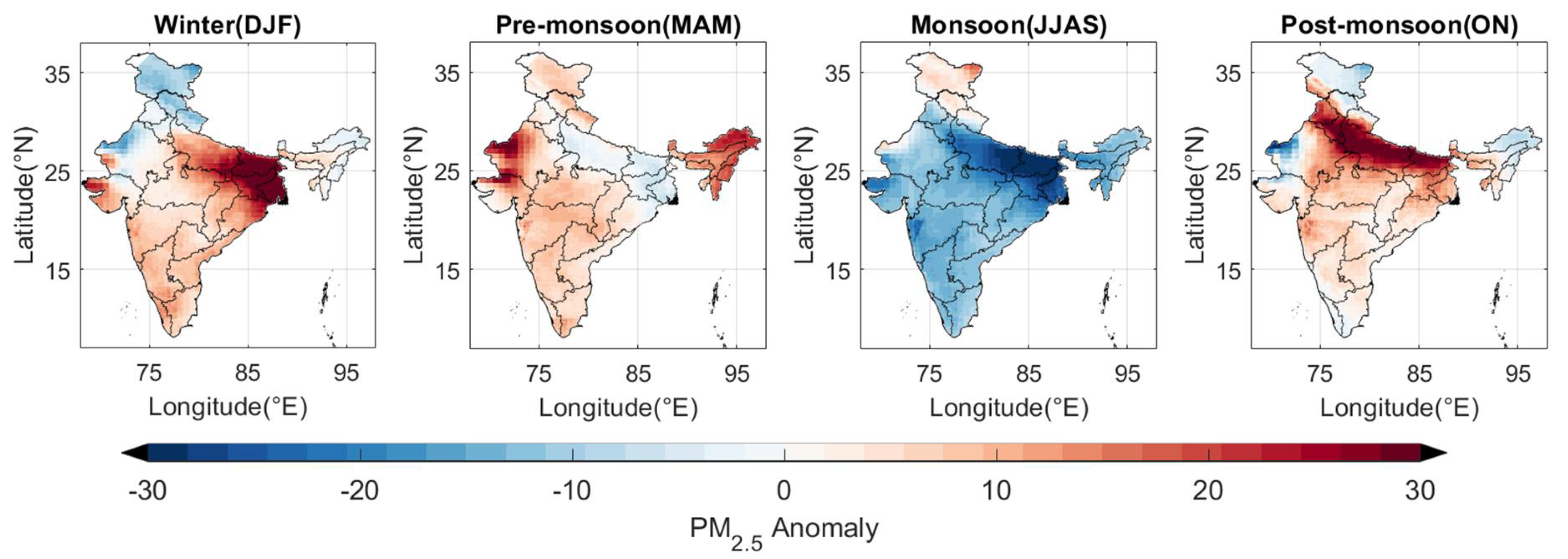

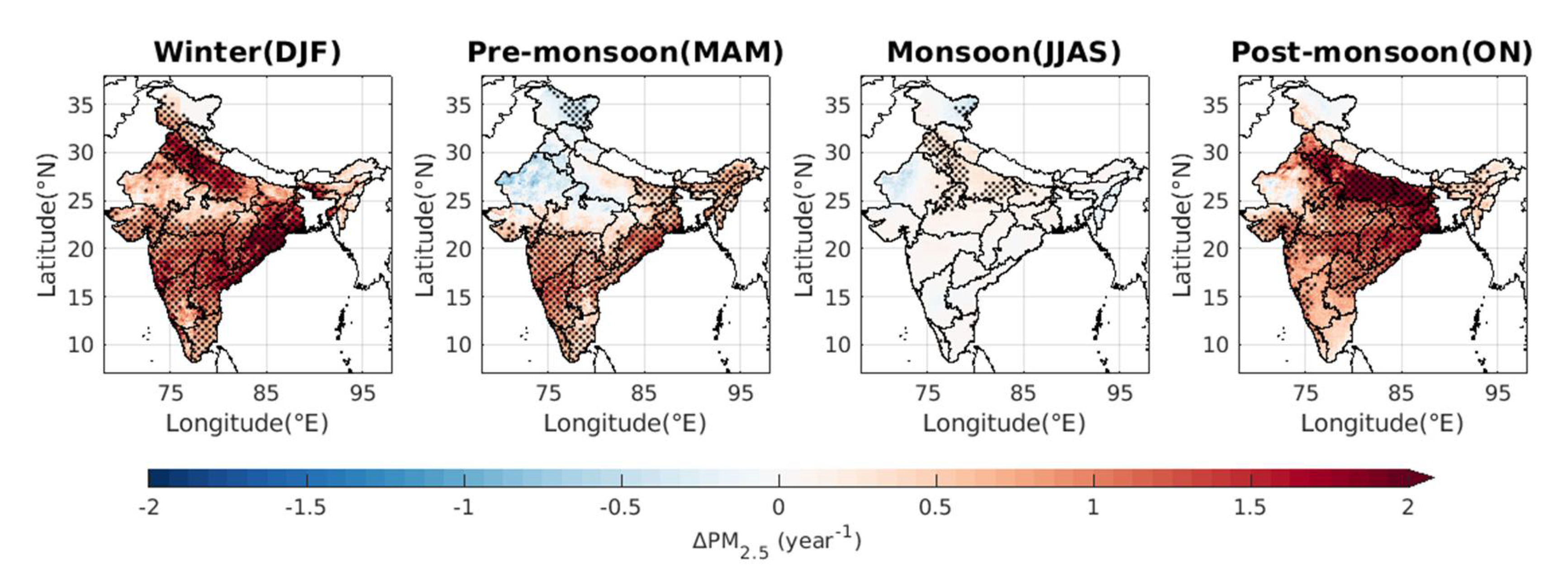
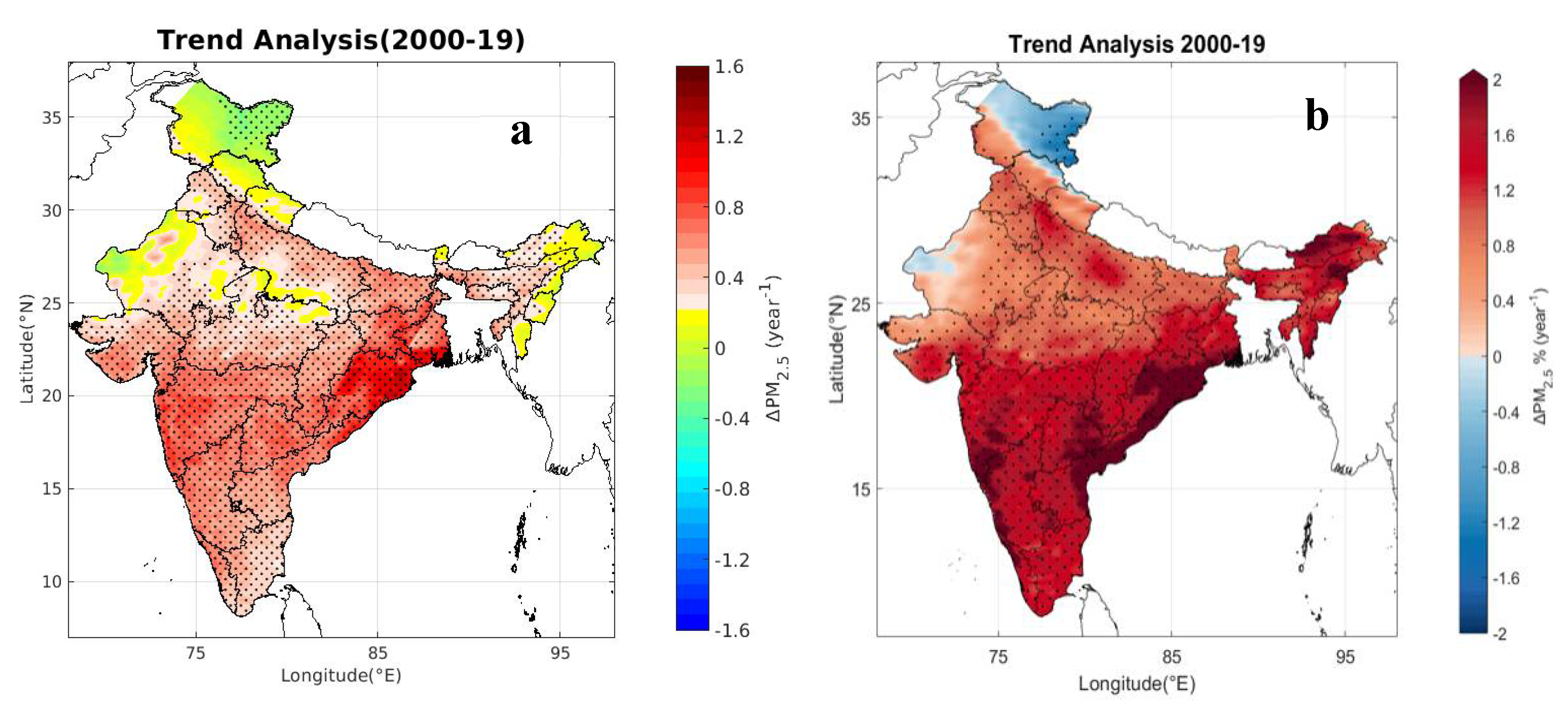
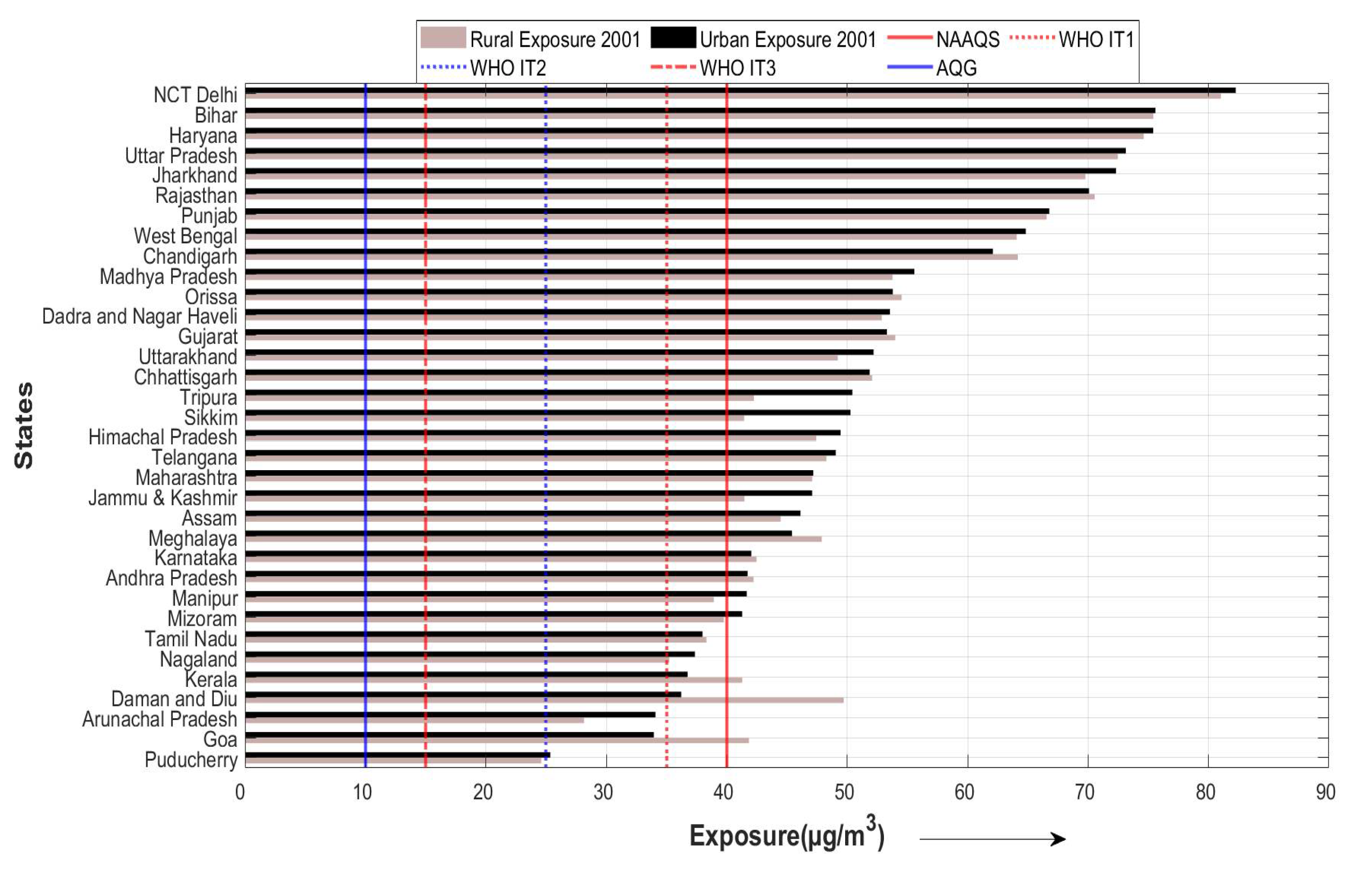
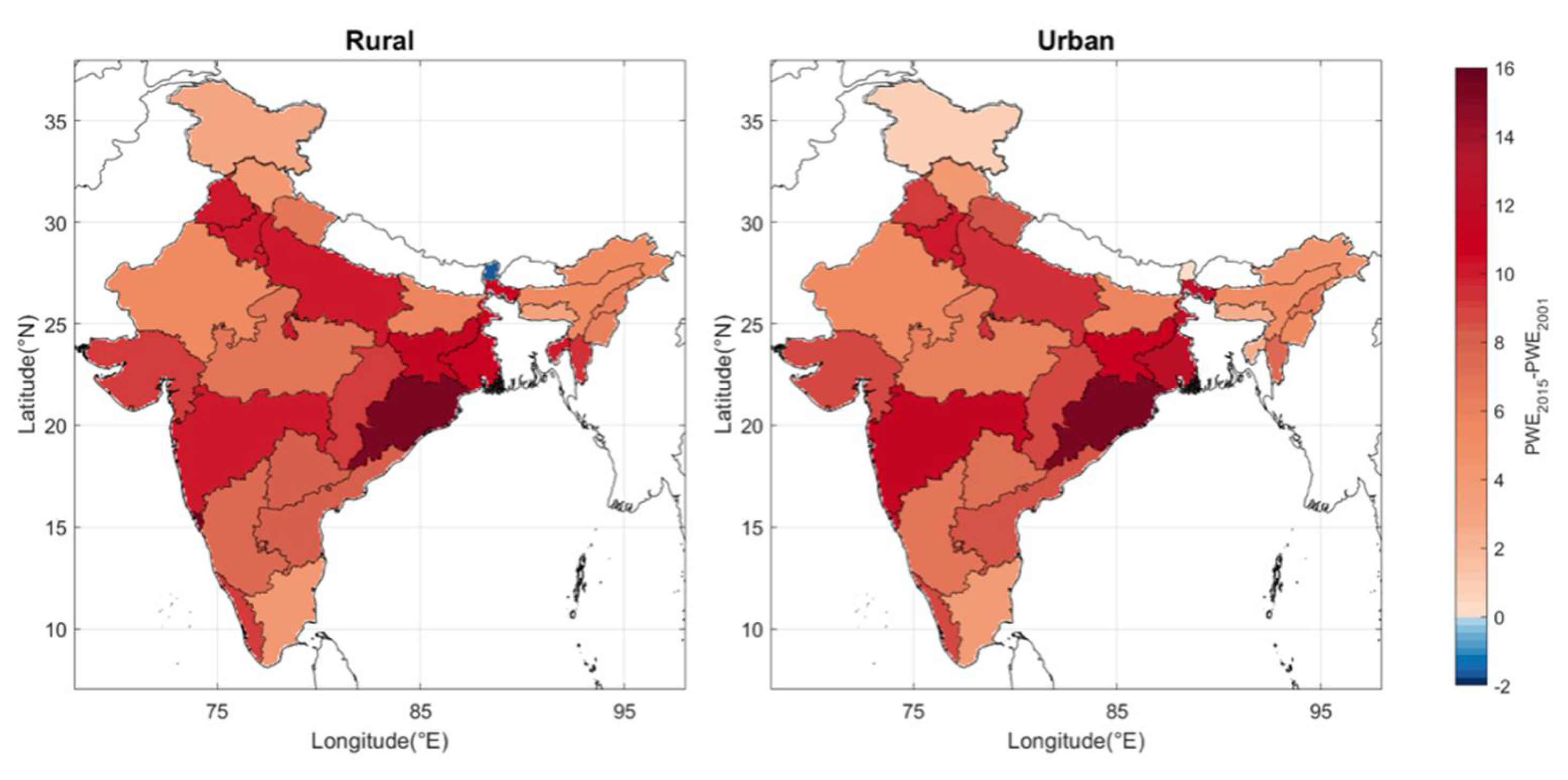
Publisher’s Note: MDPI stays neutral with regard to jurisdictional claims in published maps and institutional affiliations. |
© 2020 by the authors. Licensee MDPI, Basel, Switzerland. This article is an open access article distributed under the terms and conditions of the Creative Commons Attribution (CC BY) license (http://creativecommons.org/licenses/by/4.0/).
Share and Cite
Dey, S.; Purohit, B.; Balyan, P.; Dixit, K.; Bali, K.; Kumar, A.; Imam, F.; Chowdhury, S.; Ganguly, D.; Gargava, P.; et al. A Satellite-Based High-Resolution (1-km) Ambient PM2.5 Database for India over Two Decades (2000–2019): Applications for Air Quality Management. Remote Sens. 2020, 12, 3872. https://doi.org/10.3390/rs12233872
Dey S, Purohit B, Balyan P, Dixit K, Bali K, Kumar A, Imam F, Chowdhury S, Ganguly D, Gargava P, et al. A Satellite-Based High-Resolution (1-km) Ambient PM2.5 Database for India over Two Decades (2000–2019): Applications for Air Quality Management. Remote Sensing. 2020; 12(23):3872. https://doi.org/10.3390/rs12233872
Chicago/Turabian StyleDey, Sagnik, Bhavesh Purohit, Palak Balyan, Kuldeep Dixit, Kunal Bali, Alok Kumar, Fahad Imam, Sourangsu Chowdhury, Dilip Ganguly, Prashant Gargava, and et al. 2020. "A Satellite-Based High-Resolution (1-km) Ambient PM2.5 Database for India over Two Decades (2000–2019): Applications for Air Quality Management" Remote Sensing 12, no. 23: 3872. https://doi.org/10.3390/rs12233872
APA StyleDey, S., Purohit, B., Balyan, P., Dixit, K., Bali, K., Kumar, A., Imam, F., Chowdhury, S., Ganguly, D., Gargava, P., & Shukla, V. K. (2020). A Satellite-Based High-Resolution (1-km) Ambient PM2.5 Database for India over Two Decades (2000–2019): Applications for Air Quality Management. Remote Sensing, 12(23), 3872. https://doi.org/10.3390/rs12233872







